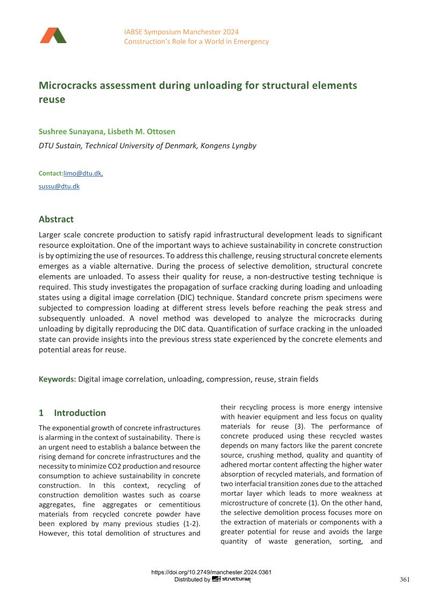Microcracks assessment during unloading for structural elements reuse

|
|
|||||||||||
Bibliographic Details
| Author(s): |
Sushree Sunayana
(DTU Sustain, Technical University of Denmark, Kongens Lyngby)
Lisbeth M. Ottosen (DTU Sustain, Technical University of Denmark, Kongens Lyngby) |
||||
|---|---|---|---|---|---|
| Medium: | conference paper | ||||
| Language(s): | English | ||||
| Conference: | IABSE Symposium: Construction’s Role for a World in Emergency, Manchester, United Kingdom, 10-14 April 2024 | ||||
| Published in: | IABSE Symposium Manchester 2024 | ||||
|
|||||
| Page(s): | 361-366 | ||||
| Total no. of pages: | 6 | ||||
| DOI: | 10.2749/manchester.2024.0361 | ||||
| Abstract: |
Larger scale concrete production to satisfy rapid infrastructural development leads to significant resource exploitation. One of the important ways to achieve sustainability in concrete construction is by optimizing the use of resources. To address this challenge, reusing structural concrete elements emerges as a viable alternative. During the process of selective demolition, structural concrete elements are unloaded. To assess their quality for reuse, a non-destructive testing technique is required. This study investigates the propagation of surface cracking during loading and unloading states using a digital image correlation (DIC) technique. Standard concrete prism specimens were subjected to compression loading at different stress levels before reaching the peak stress and subsequently unloaded. A novel method was developed to analyze the microcracks during unloading by digitally reproducing the DIC data. Quantification of surface cracking in the unloaded state can provide insights into the previous stress state experienced by the concrete elements and potential areas for reuse. |
||||
| Keywords: |
compression reuse digital image correlation unloading strain fields
|
||||
